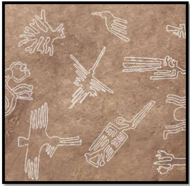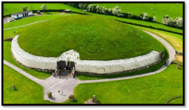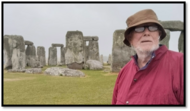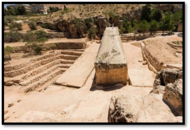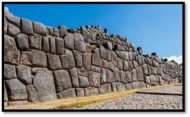Prehistory and Modern man.
Chapter 1

I have a longstanding interest in the origins of humankind and also the origins of religion. I have no formal training in this field, but I have read a lot. It would seem to me that the fact that I have no formal training is sometimes an advantage rather than a hindrance when investigating the ancient prehistory of mankind. What I mean by that is I have no preconceived ideas taught by the formal education of schools and universities. Much of the textbook teachings on archaeology, is not actually fact, even though it is taught in schools and universities as fact.
A prime example of this is the prevailing doctrine surrounding the pyramids of Giza. The standard teaching insists that these were tombs, for the pharaohs Khufu, Khafre and Menkaure. When you examine the evidence supporting this teaching, you find that it is not convincing, even though most academics will describe the evidence as “overwhelming”. Most formally trained archaeologists are therefore trained to ridicule any alternate theory to do with the pyramids. I am not trying to cast doubt on the integrity of formally trained archaeologists, it is just that they are responding in the manner in which they have been trained to respond. It is therefore my opinion that persons not being formally trained often approach a subject with an open mind, not restricted by the “established doctrine”. I do have a great deal of respect and appreciation for the work of archaeologists.
I have come across many similarities and strange anomalies amongst the material I have read over the years and, with the advent of the internet, also video material I have watched. My aim here is to try to put some of this evidence into some sort of order, which might make sense to someone else, and thereby stimulate interest in these matters and encourage the reader to explore a different train of thought. I fully expect severe criticism, assuming my writing will attract any interest whatsoever.
Petroglyphs and geoglyphs
Figure 2 Spiral petroglyphs
Perhaps our earliest records of human activity take the form of petroglyphs and geoglyphs. What is very surprizing, is the number of similar glyphs from far flung regions of the planet. A recurring theme amongst many glyphs is concentric circles, this occurs not only in petroglyphs, but also geoglyphs. Most people would not think of stone circles like Stonehenge as being a depiction of concentric circles, but that is exactly what it is. The fact that the depiction of concentric circles occurs all over the world, suggests to me that there was possibly an occurrence, witnessed all around the world which involves concentric rings.
One such possibility would be if atmospheric conditions, at some ancient time, caused a series of halo’s to be visible around the sun, or even around the moon, I have seen such rings form around both the sun and the moon, so I assume that it is possible that some condition could have caused concentric rings to be visible. What exactly might have occurred to cause such a series of halo’s, I can’t say, but for it to have affected so many primitive peoples around the world, it might have been spectacular.
Figure 4 Nasca Illustrations
Another common theme, which is quite similar, is the recurring depiction of spirals. All over the world, spirals abound in rock art especially, although it can also be found in geoglyphs, as at Nazca. Since it is such a common theme, this suggests to me that it was likely inspired by some sort of astronomical occurrence which was visible across all areas of the earth. My knowledge of astronomy is somewhat restricted, so I won’t speculate too much on what sort of occurrence might have inspired ancient artists to depict spirals.
I would imagine it might have involved an irregularly shaped meteor, or series of meteors, which moved through our atmosphere in a spiral motion. This would have made a huge impression on people of the time. The fact that spirals are so common all over the planet, suggests to me that there was very likely a time when a lot of meteors entered the atmosphere over an extended period. This is of course, speculation, and there might be a different reason for the high number of spirals in rock art.
Another very common depiction is zigzag horizontal lines. My best guess would be that the artist is trying to portray water, which makes sense, except that sometimes they are vertical, which kind of confuses the issue, although it could be a depiction of lightning, or it might just be decorative. Sometimes the lines have sharp corners and sometimes they are more “wavy “, possibly they depict different things, possibly snakes. Generally, one might assume that the ancient artists tended to depict what they witnessed in real life, animals and humans are, of course, also commonly depicted.
All of the above similarities can be easily understood, and there is no great mystery surrounding them. There are also quite a number of depictions which seem to show things one would not expect to find in ancient rock art. In such diverse areas as India, Africa, Australia and Italy, there are to be found depictions of people wearing helmets, clothing with elastic ribbed cuffs as well as accessories we would expect to see only in much more modern artwork.
Other intercontinental images would include crosses, bisected circles, crosses within circles, people with triangular bodies, people with rectangular bodies, depictions of 7 headed serpents, people with wings, flower motifs and many more. There are even depictions of what looks like UFO’s. While it could be that each artist was independently inspired, it does seem a little odd that there are so many unexplained similarities. I would suspect that these people experienced similar events and depicted them in similar ways. The writings of Erich von Daniken and others portray many such examples, which have led to an almost cult like following for the “ancient astronaut” theory. I have my doubts about this theory, but will keep an open mind.
Ancient building methods and ruins.
Figure 4 Typical Dolmen
Other strange similarities which date from ancient times, in diverse areas of the world; are building methods and structures. In the northern hemisphere across various countries, there exist odd structures, known as “dolmens”. These structures often consist of very large flat stones supported by 2 or more other standing stones. Although there are many design differences, these dolmens are generally not weather proof structures that might have been used for dwellings, they look more like they might have been shelters from large hails stones, or even meteors falling from above, this is of course just speculation. There are however, some structures, which may have been dolmens which were covered with earth to form mounds, such as New Grange in Ireland.
Most dolmens are very old and no-one has any idea why they were built, they vary considerably in size and are believed to have been built as tombs, but since most structures in archaeology are considered to be either temples or tombs, this is not necessarily true, but some were certainly used as tombs. It is possible that later people used already existing dolmens as tombs. What we do know is that there are a lot of them. Oddly, there don’t seem to be many such structures in the southern hemisphere, so far as
I know, there only isolated examples in Brazil and
Colombia, I find that very strange.
Other ancient structures, which are common around the world are stone circles, Stonehenge in England is perhaps the best known. On every continent there are circular arrangements of stones (sometimes very large).
Author at Stonehenge
These stone circles are believed to been a form of calendar, with stones positioned to align withsolstices and equinoxes. There are also other arrangements of stones, such as at Carnac in France.
Figure 7 Carnac stone alignment
William Gleeson suggests that they may depict a comet when seen from above, he may be right, for the shape is suggestive of a comet. In Japan there exist ancient tombs, which are still regarded as sacred, which have a curious “keyhole” shape. This shape would not be remarkable to me, were it not for the existence of very similarly shaped stone structures on the Arabian Peninsula, that is an odd coincidence.
In areas such as, Malta, Lebanon, Egypt, Peru and other areas there are buildings and ruins in existence which are built with dressed stone of impossibly large size, some of these show erosions that would indicate a great age. At Baalbek in Lebanon for instance, dressed stones with an estimated weight of more than 800 tons have been used in the structure, there are also further stones ready to be detached from the bedrock, which are said to be even bigger, in an adjacent quarry.
Figure 8 Stone of the South-Baalbek
In addition, the so-called polygonal masonry also occurs in far flung, seemingly unconnected areas. I suspect that the stones in this type of masonry are cast and not carved, but that is a separate matter. No matter how the blocks were made or carved, the technology would have been the same for Peru, Egypt, Italy, Japan and anywhere else this method of building was used.
Sacsayhuam in Peru
The idea that people on different continents would invent the same construction method, is a little far-fetched. In addition, there is also the use of “keystone cuts” made in adjoining blocks and filled with molten metal to bind blocks together. This system would have required portable smelters, this technology seems to have been shared amongst people on different continents including South America, Africa, Europe and Asia.
Another odd coincidence which occurs on several continents is the irrigation system called “puquios” in Peru, and known as “foggara”, “qanat”, ”falj”, “karez” and kanerjing, and occur in north Africa, China, India and Iran. There are probably similar systems in other places. This system seems to be in use still today, in mainly arid regions like Nasca in Peru. Schematic Foggara
While they do differ in detail the basic idea is the same. There is a long underground tunnel with a gentle slope which feeds water underground from the mountainous areas where the rainfall is fairly high to the arid plains below, a series of vertical access point are made along the length of the tunnel. The design of the access points differs from 1 continent to the next, but the basic idea remains the same. Is it really just coincidence that such systems exist in so many diverse regions? Or was the same engineering firm involved in the design and construction?
I have often heard the phrase “humans confronted with similar problems will invent similar solutions”, in the face of the examples already mentioned, this phrase is wearing a little thin.
Leave a comment


